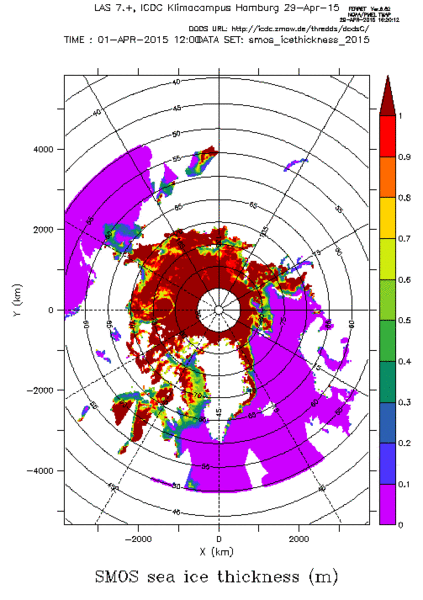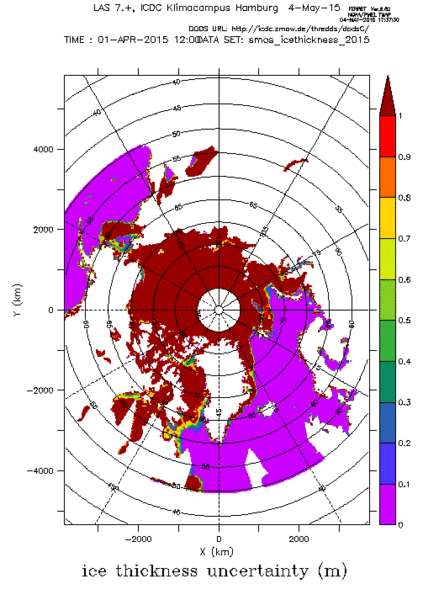Sea-ice thickness from L3C SMOS


Topics
- Access
- Description
- Parameters
- Coverage, spatial and temporal resolution
- Data quality
- Contact person
- References
- Data citation
Access
UNRESTRICTED:
RESTRICTED: This link to the data set is only available for a restricted user group. The data set is only accessible in CEN/MPI net or accessible from external nets with a customer account. Please contact ICDC if you would like to access this data from outside the network.
- View sea ice data at LAS
- Data access via file system: /data/icdc/ice_and_snow/smos_sea_ice_thickness
Description
The SMOS payload Microwave Imaging Radiometer using Aperture Synthesis (MIRAS) measures the brightness temperatures at 1.4 GHz in full polarisation with incidence angles ranging from 0° to 65°. All four Stokes parameters are obtained. It has a global coverage every three days, whereas for regions north of about 50°N and south of about 50°S complete daily coverage is achieved up to 85°N and 85°S, respectively. The footprint varies from about 35 km at nadir view to more than 50 km at incidence angles higher than 60°.
The sea ice thickness is derived from the near nadir brightness temperatures (see L3B brightness temperature at ICDC) using a single layer emissivity model [references 1, 2]. The L3B brightness temperature product contains the daily averaged brightness temperature intensities gridded onto a polar-stereographic projection with 12.5 km grid resolution. The emissivity is mainly a function of bulk ice temperature, salinity and thickness. The bulk ice temperature is estimated from surface air parameters of JRA-25 reanalysis data and a zero-dimensional thermodynamic model [references 3]. The bulk ice salinity is estimated from a sea surface salinity weekly climatology. The sea ice thickness is corrected for the influence of the thickness distribution function to account for the invalid assumption of a uniform plane ice layer [references 3]. The latter correction leads to an apparent deeper penetration depth than previously reported [references 1]. We apply no correction for the influence of ice concentration. Thus, one can expect an underestimation of ice thickness when there is open water within the SMOS footprint. We account only for the thermodynamic influence of a parameterized snow layer on the bulk ice temperature but do not account for the direct radiative effect [references 4].
Starting on October 17 2013 SMOS Sea ice thickness maps are updated daily and can be viewed in the LAS when choosing the current year.
The ESA changed the L1C product version from 5.05 to 6.20 starting on May 5, 2015.
Since October 21 2016 the new version 3 replaces version 2. Version 3 comes with an enhanced sea ice thickness retrieval as well as an improved uncertainty estimation.
Since November 21, 2019 we provide Version 3.2, that amongst others fixed interpolation problems, see Readme-First document under references.
Since November 25, 2021 we provide Version 3.3, see Readme-First
This data set is a ESA STSE SMOSIce / CliSAP Product.
Last update of data set at ICDC: daily
Parameters
| Name | Unit |
|---|---|
| Sea Ice Thickness | m |
| Ice Thickness Uncertainty | m |
| Snow / Ice Surface Temperature | K |
| Ratio of retrieved ice thickness and maximal retrievable ice thickness | % |
| Brightness temperature intensity | K |
| Brightness temperature intensity standard deviation | K |
| Relative fraction of RFI-contaminated measurements in total measurements | % |
| Number of brightness temperature data pairs per grid cell | - |
Coverage, spatial and temporal resolution
Period and temporal resolution:
- all winter (= October 15 to April 15) seasons since 2010/10
- Daily updated
Coverage and spatial resolution:
- Northern hemisphere poleward of 50°N
- Spatial resolution: 12.5 km x 12.5 km, polar-stereographic grid of the NSIDC polar-stereographic projection (see references) at standard latitude of 70°N
- Geographic longitude: 0°E to 360°E
- Geographic latitude: 50°N to 90°N
- Dimensions: 608 columns x 896 rows
- Altitude: 0.0m
Format:
- NetCDF
Data quality
This data set contains an estimation of SMOS retrieved sea-ice thickness uncertainty.
The estimation is made based on the standard deviations of brightness temperature, ice temperature, and ice salinity; it does also include a contribution of the sea-ice thickness distribution used. The uncertainty increases significantly for thicker ice.
The assumption of 100% ice concentration leads to an underestimation of sea-ice thickness for the grid cells with sea-ice concentration less than 100%.
Strong underestimation exists for the thick ice due to the saturation of SMOS brightness temperature with thickness.
The maximum retrievable sea-ice thickness is limited. It depends on sea-ice salinity and temperature. Accordingly the maximum retrievable sea-ice thickness varies with region and season. Therefore, the sea-ice thickness should always be combined with its uncertainty (when viewing with the LAS) and/or with the ratio between retrieved and maximum retrievable sea-ice thickness (see parameters ).
Data with an uncertainty > 1 m or with a ratio between retrieved and maximum retrievable sea ice thickness near 100% must not be used.
Information about a validation campaign carried out in the Barents Sea in 2014 can be found in the Data Acquisition Report and in Kaleschke et al., 2016 (see references).
Data gaps exist from Dec. 27-31, 2010, due to problems with the antenna. Monthly reports about SMOS data quality and anomalies can be found on the ESA website (see references).
Contact
Project Scientist
Xiangshan Tian-Kunze
Alfred Wegener Institut für Polar- und Meeresforschung (AWI) / Bremerhaven
email: xiangshan.tiankunze (at) awi.dePrincipal Investigator
Lars Kaleschke
Alfred Wegener Institut für Polar- und Meeresforschung (AWI) / Bremerhaven
email: lars.kaleschke (at) awi.deESA SMOS Mission Management
Klaus Scipal
ESA-ESTEC
email: klaus.scipal (at) esa.intStefan Kern
ICDC / CEN / University of Hamburg
E-Mail: stefan.kern"AT"uni-hamburg.deRemon Sadikni
ICDC / CEN / University of Hamburg
E-Mail: remon.sadikni@uni-hamburg.de<br />(remon.sadikni"AT"uni-hamburg.de)
References
Literature:
- SMOSice 2014 Data Acquisition Report, AWI, Technical Report No. 1, 2014 (pdf, not barrier-free)
- Kaleschke, L. et al. (2016), SMOS sea ice product: Operational application and validation in the Barents Sea marginal ice zone, Remote Sensing of Environment, Volume 180, July 2016, Pages 264-273, ISSN 0034-4257, http://dx.doi.org/10.1016/j.rse.2016.03.009 (pdf, not barrier-free)
- SMOS Sea Ice Thickness, ReadMe-first Technical Note(RM-TN), ReadMe-first Technical NoteDate: 13.10.2021, Issue:2.0 (pdf, not barrier-free)
- SMOS Sea Ice Thickness Product Description Document (PDD) v3.3 (pdf, not barrier-free)
- Kaleschke, L., et al., 2017, SMOS+SeaIce Final Report, ESA Support To Science Element (STSE) Contract No.: 4000112022/14/I-AM, version: August 28, 2017, 143 pages, Univ. Hamburg, Institute of Oceanography. (pdf, not barrier-free)
- Documentation/Final Report: Kaleschke, L., X. Tian-Kunze, N. Maaß, G. Heygster, M. Huntemann, H. Wang, S. Hendricks, T. Krumpen, R. Tonboe, M. Mäkynen, C. Haas: SMOS Sea Ice Retrieval Study (SMOSIce)", ESA Support To Science Element (STSE), Final Report ESA ESTEC Contract No.: 4000101476/10/NL/CT, 380 pages, Univ. Hamburg, Institute of Oceanography, 2013 (pdf, not barrier-free)
- [1] Kaleschke, L., X. Tian-Kunze, N. Maaß, M. Maekynen, and M. Drusch: Sea ice thickness retrieval from SMOS brightness temperatures during the Arctic freeze-up period, Geophys. Res. Lett., doi:10.1029/2012GL050916, 2012
- [2] Kaleschke, L., Maaß, N., Haas, C., Hendricks, S., Heygster, G., and Tonboe, R. T.: A sea-ice thickness retrieval model for 1.4 GHz radiometry and application to airborne measurements over low salinity sea-ice, The Cryosphere, 4, 583-592, doi:10.5194/tc-4-583-2010, 2010 (pdf, not barrier-free)
- [3] Tian-Kunze, X., Kaleschke, L., Maaß, N., Mäkynen, M., Serra, N., Drusch, M., and Krumpen, T.: SMOS-derived sea ice thickness: algorithm baseline, product specifications and initial verification, The Cryosphere, 8, 997-1018, doi:10.5194/tc-8-997-2014, 2014
- [4] Maaß, N., Kaleschke, L., Tian-Kunze, X., and Drusch, M.: Snow thickness retrieval over thick Arctic sea ice using SMOS satellite data, The Cryosphere, 7, 1971-1989, doi:10.5194/tcd-7-1971-2013, 2013
- Kaleschke, L. and Ricker, R.,: Sea Ice Outlook - Sea Ice Thickness from CryoSat-2 and SMOS", SEARCH Regional Outlook July 2013, http://www.arcus.org/files/search/sea-ice-outlook/2013/07/pdf/regional/kaleschke_rickert.pdf, 2013 (pdf, not barrier-free)
- Wang, Q., Danilov, S., Jung, T., Kaleschke, L., and Wernecke, A.: Sea ice leads in the ARctic Ocean: Model assessment, interannual variability and trends, Geophysical Research Letters, 43, 7019-7027, 2016. (pdf, not barrier-free)
- Tian-Kunze, X., Kaleschke, L., Maaß, N., Mäkynen, M., Serra, N., Drusch, M., and Krumpen, T.: SMOS-derived thin sea ice thickness: algorithm baseline, product specifications and initial verification, The Cryosphere, 8, 997–1018, doi:10.5194/ tc-8-997-2014, https://doi.org/10.5194/tc-8-997-2014 , 2014.
Websites:
- SMOS ESA website, https://earth.esa.int/smos/
- NSIDC polar-stereographic projection, http://nsidc.org/data/polar_stereo/tools_geo_pixel.html
- Video: Arctic sea ice observed from new ESA and JAXA satellites
Data citation
Please cite the data as follows:
Tian-Kunze, X., Kaleschke, L., Maaß, N., Mäkynen, M., Serra, N., Drusch, M., and Krumpen, T.: SMOS-derived thin sea ice thickness: algorithm baseline, product specifications and initial verification, The Cryosphere, 8, 997–1018, doi:10.5194/ tc-8-997-2014, URL www.the-cryosphere.net/8/997/2014/, 2014.
Kaleschke, L. et al. (2016), SMOS sea ice product: Operational application and validation in the Barents Sea marginal ice zone, Remote Sensing of Environment, Volume 180, July 2016, Pages 264-273, ISSN 0034-4257, http://dx.doi.org/10.1016/j.rse.2016.03.009
and with the following acknowledgments:
The production of SMOS sea ice thickness data was funded by the ESA project SMOS & CryoSat-2 Sea Ice Data Product Processing and Dissemination Service, and data from DATE to DATE were obtained from AWI [Last access date: DATE of downloading the data].
Thanks to ICDC, CEN, University of Hamburg for data support.
